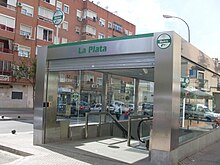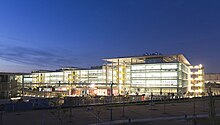
Seville is the capital and largest city of the Spanish autonomous community of Andalusia and the province of Seville. It is situated on the lower reaches of the River Guadalquivir, in the southwest of the Iberian Peninsula.
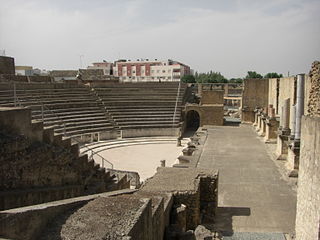
Seville has been one of the most important cities in the Iberian Peninsula since ancient times; the first settlers of the site have been identified with the Tartessian culture. The destruction of their settlement is attributed to the Carthaginians, giving way to the emergence of the Roman city of Hispalis, built very near the Roman colony of Itálica, which was only 9 km northwest of present-day Seville. Itálica, the birthplace of the Roman emperors Trajan and Hadrian, was founded in 206–205 BC. Itálica is well preserved and gives an impression of how Hispalis may have looked in the later Roman period. Its ruins are now an important tourist attraction. Under the rule of the Visigothic Kingdom, Hispalis housed the royal court on some occasions.
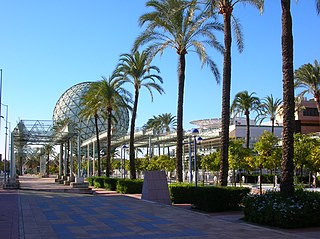
Isla de la Cartuja is an island in the Guadalquivir River at Seville, Spain.

Holy Week in Seville is one of two biggest annual festivals in Seville, Andalusia, Spain, the other being the Feria de Abril, which follows two weeks later. It is celebrated in the week leading up to Easter, and features the procession of pasos, floats of lifelike wooden sculptures of individual scenes of sorrowful Mysteries of the Rosary, or images of the grieving Virgin Mary.

Macarena is one of the eleven districts into which the city of Seville, capital of the autonomous community of Andalucía, Spain, is divided for administrative purposes. It is located in the north of the city, bordered to the south by the Casco Antiguo and San Pablo-Santa Justa suburbs, to the east and north by Norte and to the west by Triana. It covers the area between the Guadalquivir River and the Carmona Highway and from the SE-30 ring-road in the north to the Ronda del Casco Antiguo. It contains smaller neighbourhoods such as León XIII, Miraflores, and the Polígono Norte as well as the Miraflores park along the SE-30. The district contains the Andalucian Parliament, the Torre de los Perdigones in the park of the same name, and the Hospital Universitario Virgen Macarena
Nervión is a district of Seville, Spain. It lies to the east of the city centre, to the north of the Distrito Sur, to the south of San Pablo-Santa Justa and to the west of Cerro-Amate.

Triana is a neighbourhood and administrative district on the west bank of the Guadalquivir River in the city of Seville, Spain. Like other neighborhoods that were historically separated from the main city, it was known as an arrabal. Triana is located on a peninsula between two branches of the Guadalquivir, narrowly linked to the mainland in the north. Two other districts are also usually included in this area, Los Remedios to the south and La Cartuja to the north.

Los Remedios is a district of Seville, the regional capital of Andalusia, Spain. It is located on the Isla de La Cartuja, south of the district of Triana, between two forks of the Guadalquivir river. It is linked by bridge to the city centre and the districts of Distrito Sur and Bellavista-La Palmera. From the western side of the island, it is linked by road bridge to the city of San Juan de Aznalfarache and shares a boundary in the Guadalquivir with the city of Gelves. The southern tip of La Cartuja is opposite the municipality of Dos Hermanas.

The Alameda de Hércules , or simply La Alameda, is a garden square or mall in Seville, southern Spain. Built in 1574, it was originally a promenaded public garden, named after the eight rows of white poplar trees that fill its central part. Located in the northern half of the city's casco antiguo, between the Guadalquivir River and the Macarena neighbourhood, it was the oldest public garden in Spain and Europe.

El Arenal is a neighbourhood in the historical centre of Seville, the Casco Antiguo. It lies on the east bank of the Guadalquivir river to the west of the old Jewish Quarter, Santa Cruz, and south of the neighbourhoods of Museo and Alfalfa. Its name comes from the sandy nature that this east bank of the river once used to have. El Arenal has a history characterised by its former position as the port of Seville, until river silting forced the city to relocate the port to the southern edge of the city in the 17th century.

The Casco Antiguo is the city centre district of Seville, the capital of the Spanish region of Andalusia. The Casco Antiguo comprises Seville's old town, which lies on the east bank of the Guadalquivir river. It borders the districts of Macarena to the north, Nervión and San Pablo-Santa Justa to the east, and the Distrito Sur to the south. Bridges across the Guadalquivir link the Casco Antiguo to Los Remedios, Triana and La Cartuja.

Gelves is a city located in the province of Seville, in Andalusia, Spain. According to the 2006 census (INE), the city has a population of 8,325 inhabitants. It lies on the west bank of the Guadalquivir river.
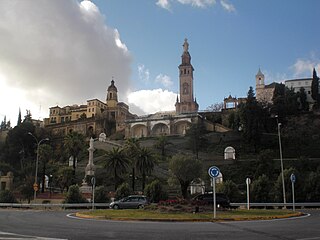
San Juan de Aznalfarache is a city located in the province of Seville, Spain. According to the 2006 census (INE), the city has a population of 20,121 inhabitants.

The Monastery of Santa María de las Cuevas, also known as the Monastery of the Cartuja (Charterhouse), is a religious building on the Isla de La Cartuja in Seville, southern Spain. The Andalusian Contemporary Art Center (The Centro Andaluz de Arte Contemporáneo (CAAC)) is now located on this site.

The Walls of Seville are a series of defensive walls surrounding the Old Town of Seville. The city has been surrounded by walls since the Roman period, and they were maintained and modified throughout the subsequent Visigoth, Islamic and finally Castilian periods. The walls remained intact until the 19th century, when they were partially demolished after the revolution of 1868. Some parts of the walls still exist, especially around the Alcázar of Seville and some curtain walls in the barrio de la Macarena.

Bellavista-La Palmera is a district of the city of Seville, the regional capital of the Spanish region of Andalusia. It is situated on the eastern bank of the Guadalquivir river, to the south of the city centre.
There are numerous sights and landmarks of Seville. The most important sights are the Alcázar, the Seville Cathedral, and the Archivo General de Indias, which are UNESCO World Heritage Sites.
Urban transports of Seville Municipal Corporation (TUSSAM) manages the bus service and urban trams in Seville, Spain.
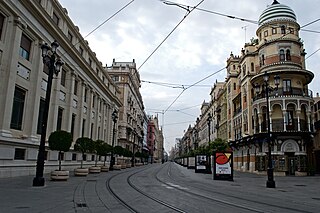
Avenida de la Constitución is an important avenue in the Casco Antiguo district of Seville, Andalusia, Spain. It starts from the square known as Puerta de Jerez and reaches the Plaza Nueva, considered the center of the city and where the historic building of the Seville City Council is located. It has a length of 600 m (0.37 mi).
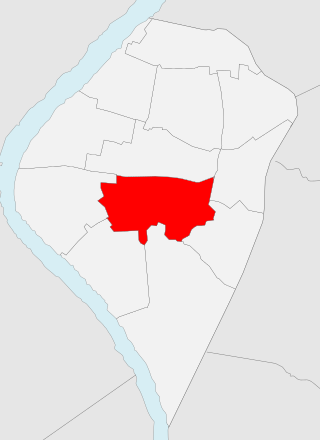
Alfalfa is a neighbourhood in the historical centre of Seville, the Casco Antiguo. It is located in the center of the district and bordered by Encarnación-Regina to the north, Santa Catalina and San Bartolomé to the east, Santa Cruz and El Arenal to the south and Museo to the west. In 2010, it had an estimated population of 4,197 inhabitants.










